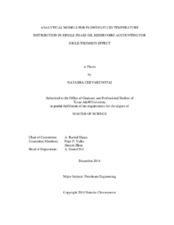| dc.description.abstract | Modern downhole temperature measurements indicate that bottomhole fluid temperature could be significantly higher or lower than the original reservoir temperature, especially in ‘more challenging’ low-permeability reservoirs, where high pressure drawdown is expected during production. This recent finding contradicts the isothermal assumption originally made for typical conventional reservoirs. In a high- pressure drawdown environment, Joule-Thomson (J-T) phenomenon plays an important role in fluid temperature alteration in the reservoir.
In this study, we developed a robust analytical model to estimate the flowing-fluid-temperature distribution in the reservoir accounting for J-T heating or cooling effect. All significant heat-transfer mechanisms for fluid flow in the reservoir, including heat transfer due to conduction, convection, and heat transfer from over- and -under-burden formations to the reservoir, as well as temperature change due to J-T phenomena, are incorporated in this study. The proposed model is successfully validated with results from a rigorous numerical simulator using field data. In general, a more accurate flowing-fluid temperature calculation leads to better estimates of well productivity index, which is one of the key parameters in production optimization and field development planning.
Sensitivity analysis results show that production rate, reservoir permeability, fluid viscosity, and J-T coefficient are critical parameters in reservoir flowing-fluid temperature calculation. Findings from the sensitivity analysis allow us to make a decision whether or not to acquire more data or to perform additional tests for a more reasonable outcome- the flowing-fluid temperature in the reservoir.
Bottomhole flowing-fluid temperature from the proposed analytical model can be further coupled with wellbore heat-transfer model to allow prediction of flowing-fluid temperature along the wellbore up to surface. The flowing-fluid temperature profile along the wellbore is normally very useful for well design and production optimization in production engineering, as well as for pressure-transient analysis. | en |


